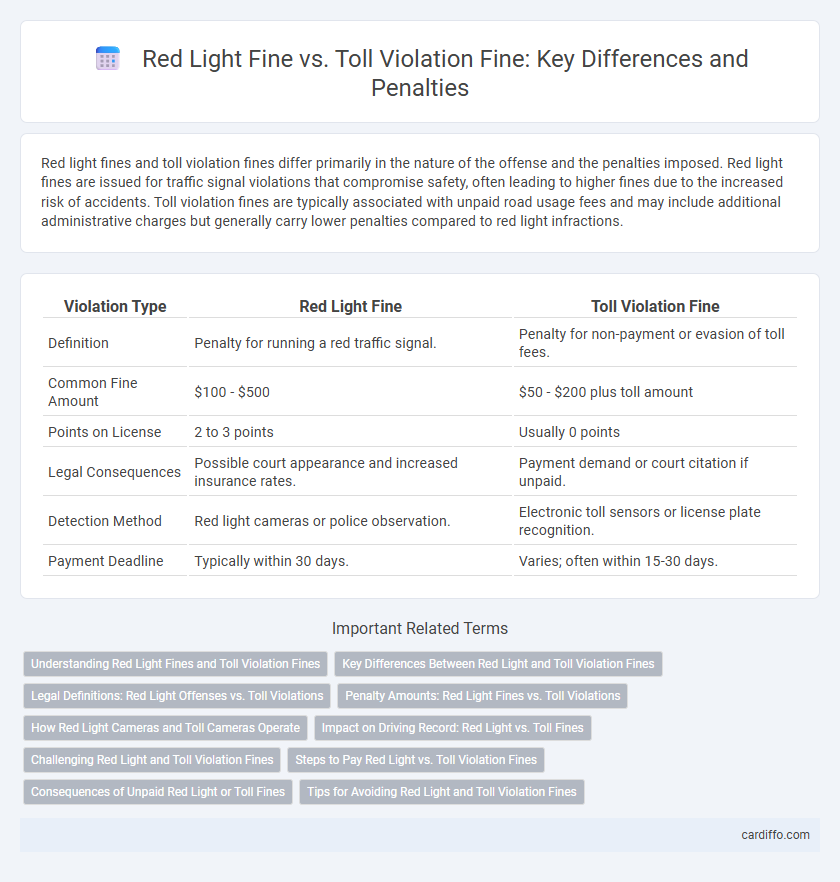Red light fines and toll violation fines differ primarily in the nature of the offense and the penalties imposed. Red light fines are issued for traffic signal violations that compromise safety, often leading to higher fines due to the increased risk of accidents. Toll violation fines are typically associated with unpaid road usage fees and may include additional administrative charges but generally carry lower penalties compared to red light infractions.
Table of Comparison
| Violation Type | Red Light Fine | Toll Violation Fine |
|---|---|---|
| Definition | Penalty for running a red traffic signal. | Penalty for non-payment or evasion of toll fees. |
| Common Fine Amount | $100 - $500 | $50 - $200 plus toll amount |
| Points on License | 2 to 3 points | Usually 0 points |
| Legal Consequences | Possible court appearance and increased insurance rates. | Payment demand or court citation if unpaid. |
| Detection Method | Red light cameras or police observation. | Electronic toll sensors or license plate recognition. |
| Payment Deadline | Typically within 30 days. | Varies; often within 15-30 days. |
Understanding Red Light Fines and Toll Violation Fines
Red light fines are penalties imposed when a driver disregards traffic signals, reflecting violations of traffic safety laws designed to prevent accidents at intersections. Toll violation fines occur when a driver fails to pay required fees for using toll roads, bridges, or tunnels, typically tracked through electronic toll collection systems. Understanding the distinct legal frameworks and enforcement mechanisms for red light and toll violation fines helps traffic authorities improve compliance and road safety.
Key Differences Between Red Light and Toll Violation Fines
Red light violation fines are typically issued for stopping at a traffic signal that displays a red light, with penalties often including higher monetary charges and potential points on the driver's license. Toll violation fines result from failing to pay tolls on highways or bridges, usually involving separate administrative fees and are less likely to affect driving records. Enforcement methods differ significantly, as red light cameras capture real-time traffic violations, while toll systems rely on electronic transponders or license plate recognition for toll collection.
Legal Definitions: Red Light Offenses vs. Toll Violations
Red light offenses involve traffic laws prohibiting vehicles from passing through intersections during a red traffic signal, and violations are typically classified as moving violations subject to fines, points on the driver's license, and potential court appearances. Toll violations occur when a driver fails to pay a required fee for using specific roadways, bridges, or tunnels, generally resulting in administrative fines rather than moving violation penalties. Legal distinctions categorize red light offenses under traffic code violations with implications for driving records, whereas toll violations are often treated as civil infractions related to nonpayment of usage fees.
Penalty Amounts: Red Light Fines vs. Toll Violations
Red light fines typically range from $100 to $500 depending on the jurisdiction, reflecting the severity of the traffic violation. Toll violation fines can vary widely, often starting at around $25 but escalating to $100 or more if unpaid for extended periods. The penalty amounts for red light violations tend to be higher due to the increased risk to public safety compared to toll infractions.
How Red Light Cameras and Toll Cameras Operate
Red light cameras capture images when a vehicle crosses an intersection after the traffic signal turns red, using sensors embedded in the road or infrared technology to detect violations and automatically trigger the camera. Toll cameras operate by reading license plates or electronic transponders as vehicles pass through toll plazas or designated toll lanes, enabling automated billing without requiring vehicles to stop. Both systems use high-resolution imaging and Automatic Number Plate Recognition (ANPR) technology to ensure accurate identification and enforcement of traffic and toll violations.
Impact on Driving Record: Red Light vs. Toll Fines
Red light fines typically result in points added to a driving record, potentially increasing insurance premiums and affecting driving privileges. Toll violation fines usually do not affect the driving record but can accumulate with late fees and lead to vehicle registration holds. Understanding the different impacts on driving records helps drivers prioritize compliance and avoid long-term penalties.
Challenging Red Light and Toll Violation Fines
Challenging red light and toll violation fines requires thorough examination of traffic camera footage and payment records to identify errors or inconsistencies. Legal defenses often hinge on proving malfunctioning equipment or incorrect vehicle identification during the alleged infraction. Understanding local traffic laws and seeking expert consultation can significantly increase the chances of a successful dispute.
Steps to Pay Red Light vs. Toll Violation Fines
Paying a red light fine typically involves visiting the local traffic court's website or office, entering the violation number, and selecting a payment method such as credit card or bank transfer. Toll violation fines require accessing the toll authority's portal, locating the vehicle registration linked to the unpaid toll, and completing payment online or by mail. Both processes emphasize timely payment to avoid increased penalties and may offer options for dispute or installment plans depending on jurisdiction.
Consequences of Unpaid Red Light or Toll Fines
Unpaid red light fines often result in increased penalties, license suspension, and potential vehicle registration holds, escalating legal and financial burdens. Toll violation fines can accumulate daily, leading to hefty late fees, potential collection actions, and restricted access to toll roads. Both types of unpaid fines negatively impact credit scores and may trigger court summons, emphasizing the importance of timely payment.
Tips for Avoiding Red Light and Toll Violation Fines
Maintaining awareness of traffic signals and toll payment methods significantly reduces the risk of red light and toll violation fines. Use apps or devices that alert drivers to upcoming traffic signals and toll plazas, ensuring timely stops and payments. Regularly updating toll accounts and adhering strictly to speed limits at intersections further helps in avoiding costly penalties.
Red light fine vs toll violation fine Infographic

 cardiffo.com
cardiffo.com